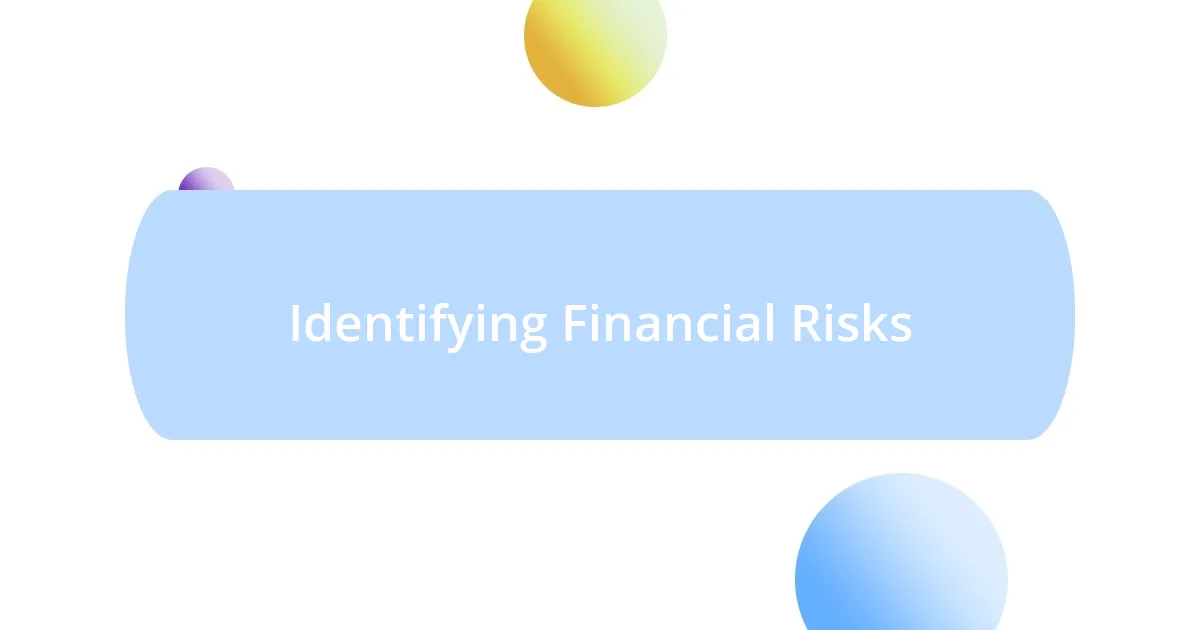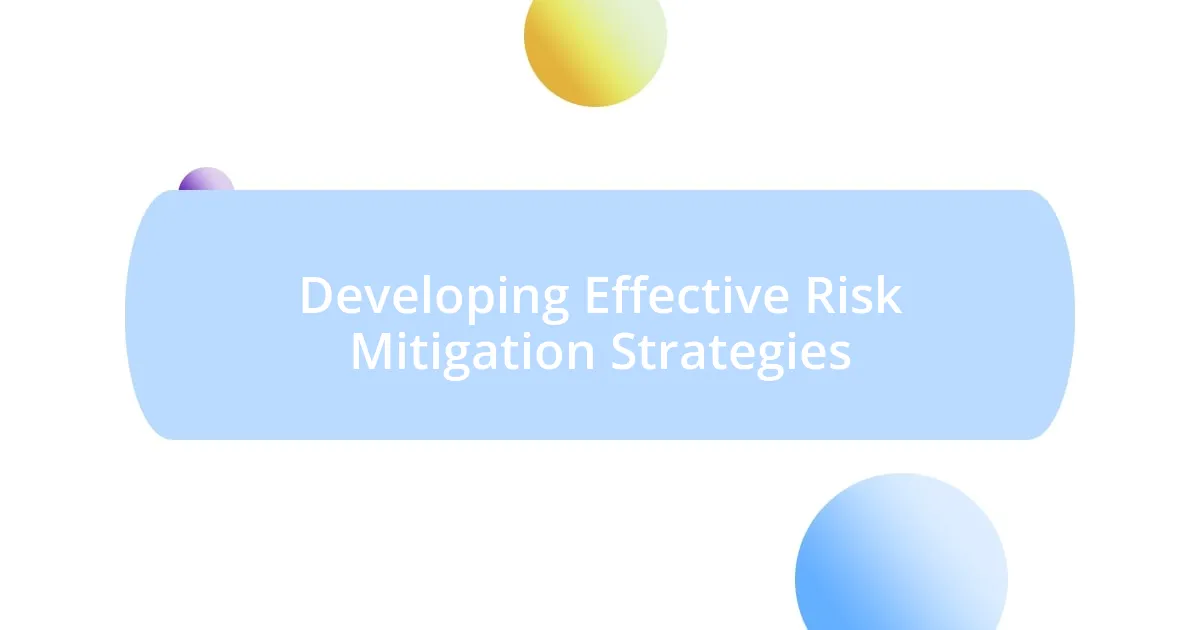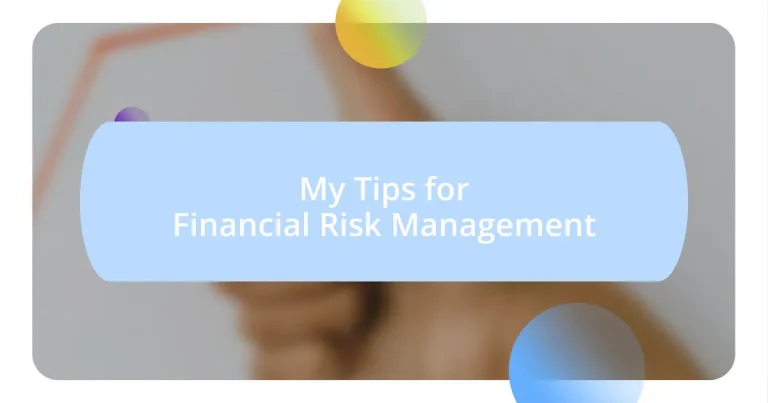Key takeaways:
- Financial risk management involves identifying and mitigating risks such as market, credit, operational, liquidity, and regulatory risks to protect investments and seize opportunities.
- Effective risk assessment requires analyzing the impact and likelihood of risks using data-driven methods, enabling better investment strategies.
- Regular monitoring and ongoing reviews of financial situations can prevent unexpected losses and enhance decision-making through proactive measures.
- Continuous improvement in risk management practices, driven by feedback and new methodologies, fosters adaptability and resilience in financial strategies.

Understanding Financial Risk Management
Financial risk management is all about identifying, analyzing, and mitigating potential losses in investments and business operations. I remember the first time I faced a major financial setback; it was a steep learning curve. This experience made me realize just how vital it is to understand various forms of risk—market risks, credit risks, and operational risks—because these elements can significantly impact our financial health.
Often, I ask myself, how prepared am I for unexpected financial turbulence? This question drives home the importance of having a solid risk management strategy. It’s not only about protecting assets but also about ensuring that one can seize opportunities even in the face of uncertainty. Just like navigating through a storm, having a clear understanding of potential risks allows us to steer our financial ship with confidence.
Furthermore, effective financial risk management involves not just analysis but also emotional intelligence. When I made hasty investment decisions out of fear or greed, it often led to regret. Acknowledging our emotional responses can make a tremendous difference in how we manage risk. By recognizing these feelings, we can better align our actions with our long-term financial goals, leading to more informed and balanced decisions.

Identifying Financial Risks
Identifying financial risks is like peeling back the layers of an onion—you might find tears along the way, but the insights you gain are invaluable. I’ve often found that the first step to recognizing any financial risk is an honest assessment of one’s situation. Sometimes, I’ve had to take a hard look in the mirror and admit that my investments weren’t as diversified as they should be. That moment of clarity helped shape my future decisions, reminding me that complacency is a risky business.
To effectively identify financial risks, consider the following factors:
- Market conditions: Fluctuations in supply and demand can impact the value of investments.
- Credit risk: The possibility that a borrower may default on a loan can jeopardize your returns.
- Operational risks: Internal processes and systems, or even human error, can lead to unexpected financial fallout.
- Liquidity risks: The struggle to convert assets into cash quickly can pose significant challenges during emergencies.
- Regulatory risks: Changes in laws and regulations can impact your financial strategies.
By systematically reviewing these areas, I’ve been able to not only mitigate possible losses but also position myself more strategically before potential challenges arise.

Assessing Risk Impact and Likelihood
Assessing the impact and likelihood of financial risks is something I’ve come to appreciate as a core part of my risk management process. Understanding the potential consequences of each risk can often feel overwhelming, but breaking it down makes it manageable. For instance, when I evaluated a potential investment, I considered not just the immediate financial implications but also how market volatility could affect my long-term return. When I realized that even a slight fluctuation could have a significant impact, it prompted me to rethink my investment strategy entirely.
On the other hand, assessing likelihood requires me to dive deep into analytics. Crunching numbers was always daunting, but I learned that even basic probability skills could significantly enhance my risk assessments. For example, I once analyzed a sector that seemed stable but had hidden vulnerabilities. Through research, I discovered that historical data indicated a 30% chance of downturns during economic shifts. That kind of insight made me adjust my portfolio to include assets that were less correlated with those trends.
When I create a comparison table to evaluate different risks, it ultimately allows me to visualize impact versus likelihood. This method has immensely helped me prioritize which risks warrant immediate attention and which can be monitored over time. Familiarizing myself with these concepts has transformed how I approach financial decisions.
| Risk Type | Impact Level | Likelihood of Occurrence |
|---|---|---|
| Market Risk | High | Moderate |
| Credit Risk | Medium | Low |
| Operational Risk | High | High |
| Liquidity Risk | Medium | Moderate |
| Regulatory Risk | High | Variable |

Developing Effective Risk Mitigation Strategies
When developing effective risk mitigation strategies, I find it crucial to take a proactive stance rather than a reactive one. For instance, I once faced a situation with a rental property that had a history of unexpected maintenance costs. Instead of waiting for issues to arise, I set aside a dedicated fund for repairs, which not only eased my financial stress but also allowed me to tackle problems promptly. Wouldn’t you prefer peace of mind over the uncertainty of future expenses?
Another powerful strategy I’ve implemented is diversification. I remember when I put a significant portion of my portfolio into a single tech stock, thinking it would yield high returns. While the initial gains were promising, a sudden market shift taught me a hard lesson about over-concentration. Today, I spread my investments across various sectors, minimizing my risk exposure. It’s fascinating how a single decision can shape your entire investment landscape, isn’t it?
Lastly, I’ve learned the importance of regularly reviewing and adjusting my strategies. Much like a coach fine-tuning a game plan, I take time every few months to assess what’s working and what’s not. A couple of years back, I invested in an emerging market that looked promising but quickly turned volatile. It was then that I recognized the need for agility in my strategy. By staying flexible and open to change, I’ve found that I can navigate the unpredictable waves of the financial world with greater confidence. What adjustments have you made in your own financial journey?

Implementing Risk Management Policies
Implementing risk management policies isn’t just about paperwork; it’s about creating a culture of awareness within an organization. When I first introduced a formal risk management policy at my workplace, I gathered my team for an open discussion. Many expressed their concerns about how risks could disrupt our projects, and it was eye-opening. By openly addressing these fears, we fostered a proactive mindset that not only empowered my colleagues but also encouraged collaboration to find solutions.
A practical example from my experience involves establishing clear guidelines for decision-making. I once encountered a situation in which a major partnership was at stake. Having a well-defined risk policy enabled us to evaluate the potential deal against our appetite for risk, which was crucial. As we navigated the decision, it became evident that aligning our choices with our risk policy not only reduced confusion but also built confidence among team members. How often do we overlook the power of a structured approach?
Moreover, I discovered the importance of continuous training in risk management. Early on, I realized that simply drafting policies wasn’t enough; I needed to ensure everyone understood them. I organized workshops, sharing scenarios and inviting questions. It was rewarding to see my colleagues develop their analytical skills and embrace risk assessments confidently. Isn’t it fascinating how investing in education can transform our perspectives on risk and ultimately lead to better outcomes?

Monitoring and Reviewing Risks
Monitoring and reviewing risks is an ongoing process that I believe can significantly enhance financial stability. I remember a time when I underestimated the impact of market fluctuations on my investments. My approach was to check my portfolio only once every few months, which left me vulnerable to sudden market changes. Now, I make it a habit to review my investments weekly. This proactive monitoring helps me catch early warning signs, allowing me to make informed decisions before it’s too late. Have you ever faced unexpected losses simply because you weren’t keeping a close enough eye on your investments?
Another essential aspect of monitoring risks is to gather feedback from various sources, including team members and financial advisors. I recall a project where we noticed unusual spending patterns that didn’t quite fit our budget. By involving my team in discussions, we identified overlooked expenses that could be addressed. This collaborative approach not only improved our understanding of potential risks but also fostered a culture of vigilance. Don’t you think that sharing insights can lead to better risk management decisions?
Lastly, embracing technology has been a game changer for me in this area. When I started using financial software to track my investments and risks, I found it liberating. The tools provide real-time data and alerts on market changes, enhancing my ability to react swiftly. For example, when a certain stock dipped unexpectedly, I received an alert that allowed me to analyze the situation and decide whether to hold, sell, or buy more immediately. It’s incredible how technology can empower us in our financial journeys, wouldn’t you agree?

Continuous Improvement in Risk Management
Continuous improvement in risk management is vital for fostering an adaptable organizational culture. I remember when I led a risk assessment initiative in my department. We developed a system to routinely solicit feedback about our practices, and, to my surprise, team members were eager to share insights that we hadn’t considered. This ongoing dialogue helped to identify gaps in our knowledge and processes, leading to real strides in our risk management approach. Have you ever implemented a system that brought unexpected clarity to a complex issue?
Another dimension of continuous improvement focuses on learning from past experiences. I’ve often reviewed project outcomes post-completion, analyzing what went well and what could have been improved. For instance, we had a project that faced numerous unexpected hurdles, which taught me about the importance of flexible planning. By documenting these lessons and sharing them with the team, I found that we became more resilient and effective in future endeavors. Isn’t it fascinating how reflecting on difficulties can lay the groundwork for stronger risk management?
Integrating cutting-edge methodologies into our risk management practices can be a leap forward as well. On one occasion, I explored a new decision-making framework that utilized data analytics. This framework not only provided quantitative insights but also merged them with our qualitative assessments. As I implemented this approach in our discussions, it transformed our risk evaluation process, leading to more informed and confident decisions. Have you explored new methods that challenged your traditional thinking? Embracing this evolution can truly enhance our understanding of risks and improve our strategies to manage them.














